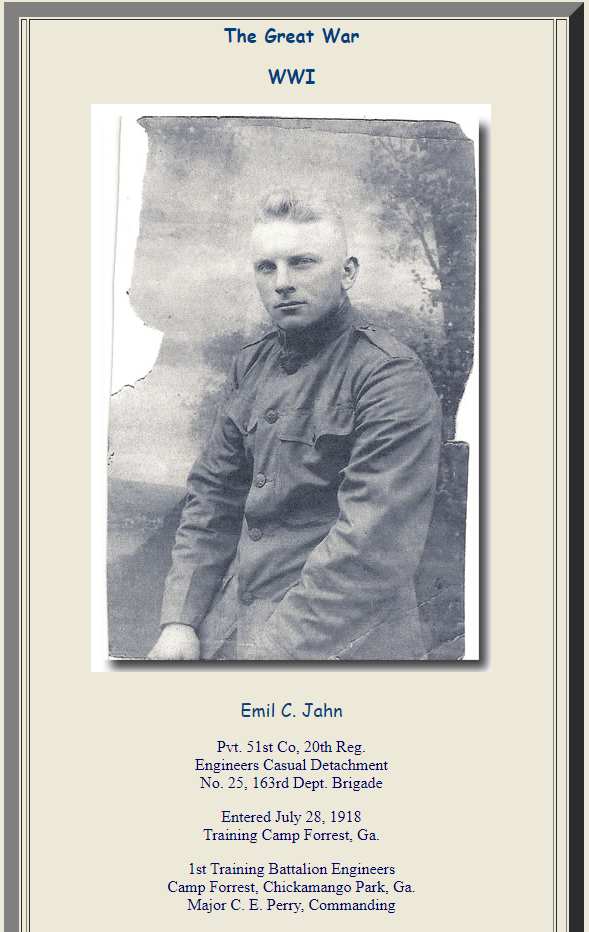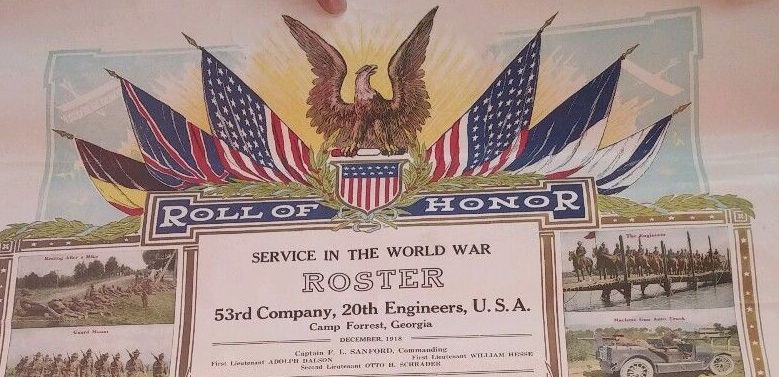

Reinforcements
Note: Most of the content of this article comes from "TWENTIETH ENGINEERS -- FRANCE -- 1917-1918-1919"
The necessity for very large additions to the forest troops in France became evident early in 1918 when the future requirements of lumber for the American Expeditionary Forces promised to be greater than the original plans for the Twentieth Engineers had contemplated. In June of that year a memorandum was submitted to the War Department calling for 18,000 additional troops for lumber supply and this was increased from time to time until the final program was for the training and shipment overseas of 24,000 men to reinforce the Twentieth Engineers.
To carry out these plans it was felt that men who had been in this work in France would be better able to anticipate needs and work out a practical organization than would all new men who would of necessity be more or less uninformed as to overseas conditions. Major Coert Dubois, Major Colin E. Clark and Capt. Paul D. Mackie were ordered to the United States late in August, together with Battalion Sergeants Major Campbell, Douglas, and Hennessy, Battalion Supply Sergeants Anderson, Samuels, and Wolff, Company Supply Sergeant Peverly and Sergeant Tragesser. The group sailed from Brest on the Leviathan September 12th and landed at Hoboken on the 19th, being given seven day's leave with orders to report to Camp Humphreys, Va., at the end of that time.
After arrival at Humphries, the Sergeants were found so valuable that it was only with great difficulty that Major Clark and Captain Mackie, stationed at Camp Forrest, Georgia, could get them transferred to the latter station. Major Dubois was stationed in the office of the Chief of Engineers. Orders actually authorizing the work of organization did not arrive until the 25th of October and the first men were received and assigned to the 1st and 2nd Forestry Replacement Companies, October 28th. Six days after these men arrive at Camp Forrest they were formed into companies, equipped, and started overseas. The overflow was made into the 3rd Company.

Private Emil Jahn was assigned to the 163rd Depot Brigade for induction into the Army, then to the 1st Engineer Training Battalion.
Camp Forrest, Chickamauga Park, Georgia, was a major center for training of Engineers of many specialties.
Private Jahn was assigned to the 51st Company, 17th Battalion as the war ended and the unit disbanded.
He was then assigned to the 213th Engineer Regiment, 13th Division, for a short period of time.
Immediately after the formation of these companies, the Sixteenth, Seventeenth, and Eighteenth Battalion organizations were formed. Under the Sixteenth Battalion Headquarters were the Fourth, Fifth, and Sixth Forestry Replacement Companies, and the Seventeenth Battalion included the 50th, 51st, and 52nd Companies, 20th Engineers.

Click on the picture for a full roster of the 53rd Company.
Had the war continued, at least two of the battalions would have been on the water very shortly, and the expectations were that the entire 24,000 would be in France in the spring of 1919. Early in December orders were received at Camp Forrest to proceed wit the demobilization of all troops as rapidly as possible and the new organizations were destroyed as rapidly as they had been formed. Practically all of the men were discharged by New Year's Day and all of them soon after, and Camp Forrest ceased to exist as a separate Engineer Camp by the end of the month.